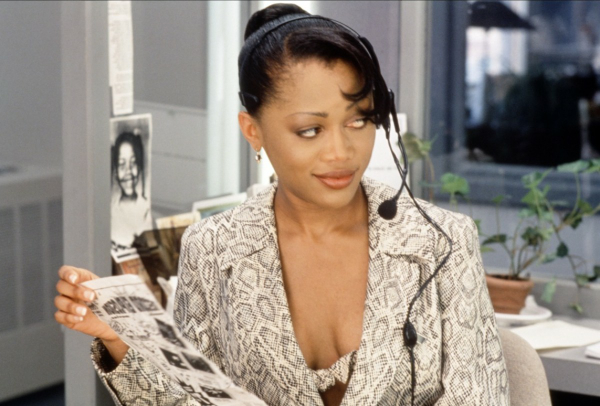Movie reflection by Greg Carlson
In 1996, six years following the disappointment of “Graffiti Bridge,” Prince agreed to provide the soundtrack music for director Spike Lee’s “Girl 6.” The project would mark the artist’s final full-scale cinematic collaboration, even though filmmakers continued to use his material and seek him out. Functionally, the “Girl 6” record — credited to Prince even though at the time he was using the unpronounceable symbol to signify his name — constitutes a fantastic collection that rivals any of the other official Warner anthologies. Only three previously unreleased songs, including “Girl 6” (which plays during the closing credits), “She Spoke 2 Me” (underscoring the opening titles), and “Don’t Talk 2 Strangers,” which was originally recorded for, but cut from, the fully reworked version of the James L. Brooks film “I’ll Do Anything,” tantalized devoted completists.
While Lee uses several familiar numbers as transitional cues, multiple songs play out in their entirety, providing a kind of thematic counterpoint to the film’s narrative that bears a close resemblance to the way in which the music in “Purple Rain” drove the action and extended the characterizations. In the film’s first scene, Lee shows Theresa Randle’s struggling actor Judy at a grim motion picture audition overseen by Quentin Tarantino (playing “QT,” a too-close-for-comfort version of his media persona). While neither “Raspberry Beret” nor “Take Me with U” showed up on the 13-track compilation sold in stores, Lee delivers them as a one-two punch, playing uninterrupted and back-to-back. For Prince fans, the familiarity and optimism of the two bright, positive songs clash with the incongruity of the ugly sexual exploitation faced by Judy at the videotaped audition.
In a commentary on the construction of identity in both screen performance and sex work, Randle’s character becomes primarily known as Girl 6 to her colleagues and Lovely to callers, supplying her heterosexual male clientele with live-chat fantasies from a drab cubicle at a female-led agency. Screenwriter Suzan-Lori Parks, who would go on to win a Pulitzer Prize for “Topdog/Underdog,” examines Girl 6’s curiosities, particularly as they relate to the power of voice and the regulation and control of the libido. While the technologies of phone sex operation would soon shift from landlines to web-based options, Parks’ script retains a freshness regarding the emotional and psychological costs of the industry on its female laborers.
Girl 6 struggles to separate the rush of her auditory encounters from offline mundanity and a failed relationship with her torch-bearing ex (Isaiah Washington). In one thread, she arranges an ill-advised face-to-face meeting with a frequent caller known as Bob from Tucson (Peter Berg). The rendezvous is to take place at Coney Island, but Girl 6/Lovely is stood up. The sequence is accompanied by the brilliant 1982 B-side “How Come U Don’t Call Me Anymore?” in what may be the movie’s most effective marriage of Prince’s music, Parks’ story, and Lee’s visuals. Later, Lee will turn to “The Cross” (one of five chosen cuts from “Sign o’ the Times,” making it the most well-represented of Prince’s albums) when Girl 6 hits rock-bottom with an abusive caller who humiliates and threatens her.
In a sequence paying homage to Dorothy Dandridge, Lee drops the needle on “Habanera” (“L’amour est un oiseau rebelle”) from Bizet’s “Carmen,” but it is the only time in the film when Prince’s music — including recordings by Vanity 6, the Family, and the New Power Generation written and produced by Prince — is not deployed. Additionally, Lee skips any other traditional accompanying score, emphatically underlining the thematic link between the Prince songs and the events that take place onscreen. Devotees are well-served by taking a second look at a largely neglected chapter in the up and down, hot and cold affair Prince had with the silver screen.
